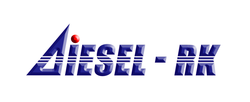Applications of DIESEL-RK
DIESEL software has been designed since 1981 - 1982. In those
years it was applied in researches of many engines with different sizes, speed and
application. All these years the software is improving to grow efficiency and field
of application. Results of simulation in every research are compared with experimental
data obtained by various authors, mainly obtained by diesels manufacturers.
Main features of program DIESEL-RK are similar to known
thermodynamic programs. However, together with conventional features, the DIESEL-RK has
new advanced applications which are absent in other programs. DIESEL-RK is oriented on
diesel combustion optimization and ICE analysis and optimization. The assumption about
identical work of all engine cylinders allows considerably increase operating speed and
one makes it possible to resolve multiparametrical optimization tasks.
Main Applications
- Torque curve and other engine performances prediction.
- Fuel consumption prediction and optimization.
- Combustion and emission analysis and optimization.
- Knock prediction.
- Valve timing optimization.
- EGR system analysis and optimization.
- Turbocharger and bypasses matching and optimization.
- Research and optimization of fuel injection profile including multiple injection, sprayer
design and location as well as piston bowl shape optimization.
- Convert of diesel engines into gas engines.
- Dual fuel engine analysis.
High operating speed of DIESEL-RK permit resolving of
multiparametrical optimization tasks, including optimization of piston bowl shape and fuel
injection system to achieve low level of NO and smoke emissions.
Computational researches with optimization can be
carried out very fast and without large expenditures. The software does not require
powerful computer.
After termination of computing, data about fuel sprays
evolution including interaction of them are presented in a convenient form. It allows step
by step caring out optimal design of piston bowl and sprayer to achieve optimal conditions
of sprays evolution with minimal losses due to intersection of free sprays and wall surface flows
generated by sprays.
Some examples of researches and obtained results are presented
below.
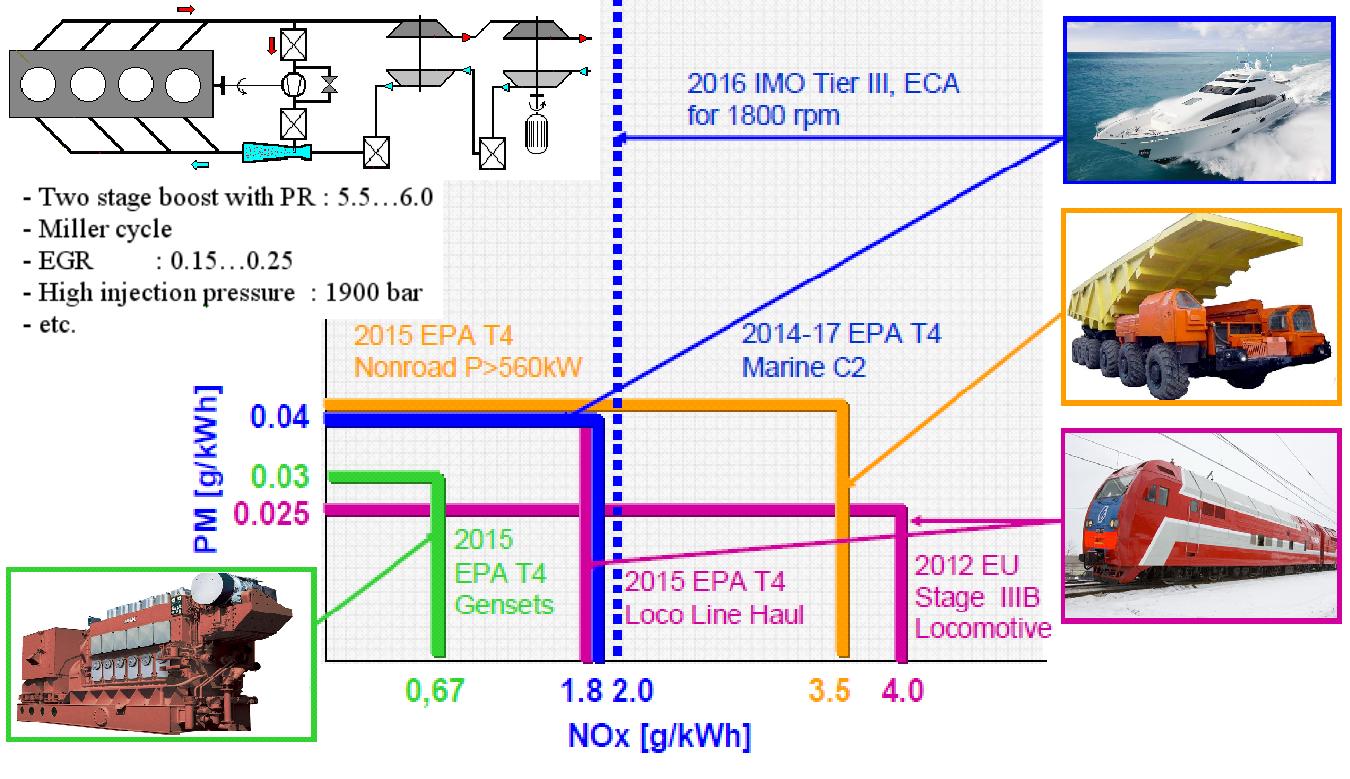 |
Optimization of medium speed diesel engine parameters to meet the 2012 EU
Stage IIIB regulations.
The research includes common optimization
of the following parameters:
- Intake Valve Timing (Miller cycle);
- Injector holes number, diameter, and orientation;
- EGR (with the account of a Venturi nozzle dimensions and power for EGR
pump drive...);
- Injection pressure;
- Injection profile shaping;
- Boost pressure;
- Compression ratio.
Automatic optimization is carried our at few operating points having own weight
coefficients...
See details >>
|
Matching the piston bowl shape and spray angle for the locomotive diesel.
Computational research and optimization of sprayer
nozzles orientation for different piston bowl shapes has been performed.
Analysis of fuel sprays evolution in contact with walls as well as
distribution of fuel in characteristic zones has been done for part load and
full capacity. Conclusion about dependence of optimal piston bowl shape on
BMEP was made. See
details>>
|
 |
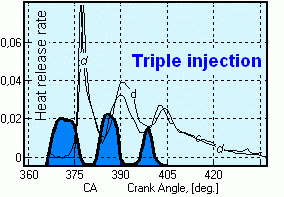 |
Simulation of mixture formation, combustion and NO emission in truck diesel with
different strategies of injection. Examples of simulation of mixture formation, combustion and NO emission in
one-cylinder truck diesel equipped with Common Rail fuel injection system
are presented in comparison with experimental data.
See
details>> |
Simulation of mixture formation and combustion in two-stroke
marine diesel with side injection system. An
example of simulation of mixture formation, fuel distribution and combustion in cylinder of
low-speed marine diesel is presented. Fuel sprays tip penetration (in
swirled air) were calculated and compared with experiment and with
calculated by CFD software. See
details>>
|
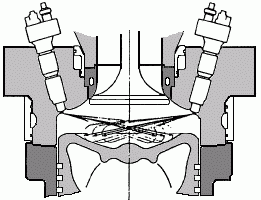 |
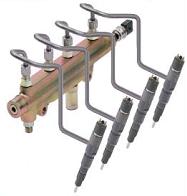 |
Development of Common Rail system controlling algorithm.
At
first, simulation of high speed diesel with Bosch VE fuel system was carried out over
whole operating range (with identical empirical coefficients). Calculated data are well
corresponded with experimental ones. Next step: at several operating modes the
optimization of injection parameters of Common Rail system was carried out to decrease NO
and PM emission. On a base of optimal solutions a map of injection pressure, injection
duration and injection timing was obtained for the whole operating range. See details>>
|
Simulation of medium-speed diesel combustion at split injection. An
example of simulation of mixture formation and combustion in cylinder of medium speed
locomotive diesel with double stage injection is presented. Heat release rate curves
obtained in calculation and in testing are compared. See
details>>
|
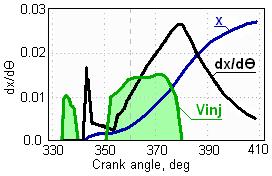 |
 |
Simulation of diesels over the whole operating range.
After calibration of ICE
model, DIESEL-RK provides accuracy simulation of engine over whole operating range. Images
of mixture formation and heat release diagrams are presented for different operating modes
of:
- high-speed diesel. See
details>>
- truck diesel YaMZ-238D. See details>>
- medium speed locomotive diesel. See details >>
|
Simulation of gas exchange and combustion of truck diesel at different operating modes.
Calculated
and measured diagrams of heat release rate and pressures in cylinder and manifolds are
compared at different operating modes. Image of mixture formation and analysis of
allocation of fuel in characteristic zones are presented for full load. See details >>
|
|
|
Analysis of allocation of injected fuel in characteristic zones of
combustion chamber for diesel engines with different conditions of a mixture formation. See details >>
|
Calculation of a gas pre-chamber engine (diesel MTU 396 converted for
operation on natural gas). Comparison between calculated and experimental curves of
pressure in the cylinder and diagrams of prechamber pressure and temperature are
presented.
See
details>> |
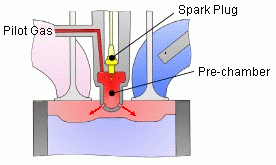 |
|
Research aimed to decrease NO emission of naturally aspirated diesel.
Numerical
research of possibility to decrease a level of NOx emission of diesel engine by means of
optimization of the piston bowl shape, by veering of fuel jets evolution, by decrease of
injector nozzles diameter, by increase of compression ratio, etc. A sequence of
optimization steps and theirs results are presented. See details >>
|
Multiparametrical optimization of a medium-speed marine diesel at increase its
capacity. Research aimed to achieve minimal SFC at increase engine power by a
factor 25%. Optimization parameters include designed angles of HP and LP turbines nozzles
outlet of two-stage free turbocharger, valve timing, CR, etc. A sequence of
optimization steps and theirs results are presented. See details >> |
|
To home page










|
